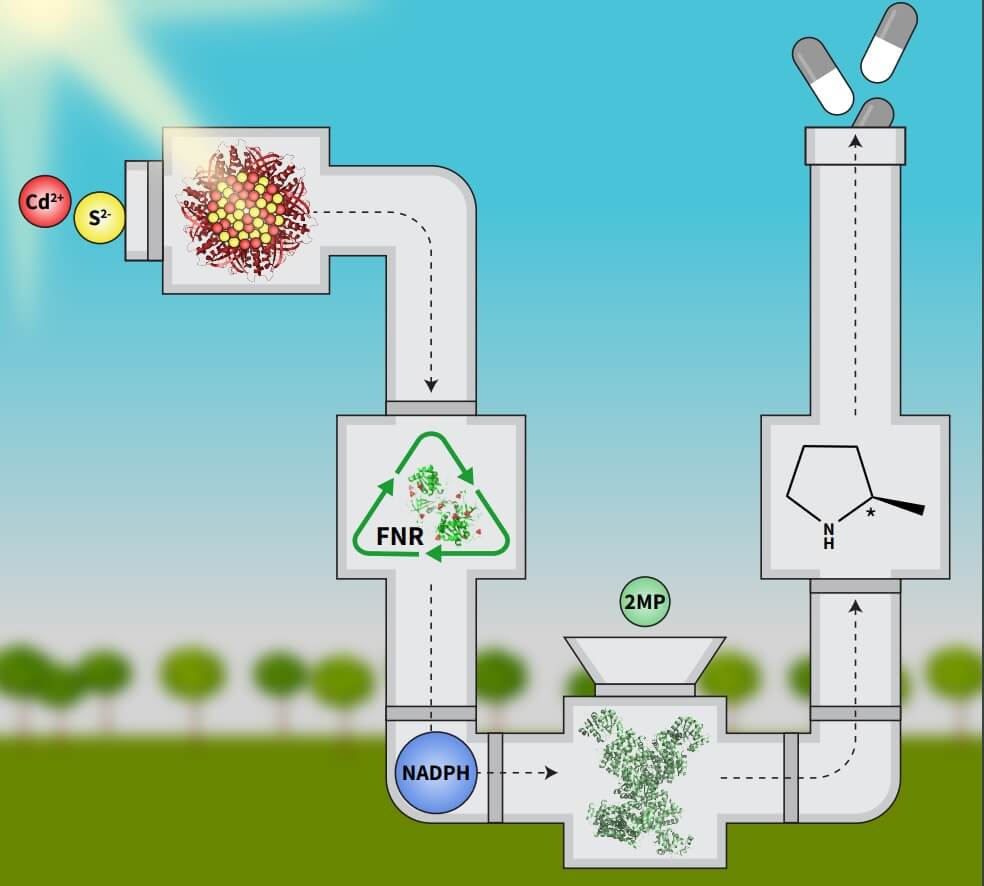The researchers use the unique properties of nanoscale particles on the one hand, and the tremendous selectivity of biological systems on the other, to create biosystems that carry out vital processes

Researchers at the Faculty of Biotechnology and Food Engineering at the Technion have developed a "bionic bacterium". The innovative technology has many potential applications in industry (improved production of materials and fuels), in environmental quality (monitoring dangerous substances using bacteria) and in precision medicine (targeted release of drugs in the target tissue in the body using external light). The research was led by Dr. Omer Yehezkali and doctoral student Oren Bachar, and his partners were doctoral student Matan Meirovich and master's student Yara Zivak. The journal Angewandte Chemie International Edition, which published the study, chose it as an outstanding article.
"My research group deals with the interface of engineering and biotechnology at the nanometer level," explains Dr. Yehezkali. "Our goal is to blur the boundaries that exist between the various disciplines and especially between nanometer materials and biological systems such as bacteria. In our research, we use the unique properties of nanoscale particles on the one hand, and the tremendous selectivity of biological systems on the other, to create biosystems that carry out vital processes."
Nanoscale semiconductor particles are usually produced by chemical processes that require high temperatures and organic solvents. In the current study, the researchers were able to create, using engineered proteins, an environment that allows the growth of nanometer particles that are active in light-induced processes under biological conditions and at room temperature. According to Dr. Yehezkali, "Using engineered proteins for the self-growth of nanoscale materials is a promising strategy that opens up new scientific horizons for combining inanimate and living matter. In the current study, we demonstrated the use of engineered proteins to grow semiconductor nanomaterials of the CdS type that are capable, through light radiation, of recycling NADPH, a molecule of crucial importance in many enzymatic processes."
Enzymes are common biological components that participate in most activities in the living cell. These are protein structures that drive desired actions by creating an appropriate biochemical environment. Billions of years of evolution have led to the development of a wide spectrum of enzymes responsible for the many and varied functions in the cell.
In this work, the researchers showed that NADPH can be produced (recycled) using a genetically edited SP1 protein. This protein is made up of 12 subunits that form a "doughnut"-like structure with a hole with a diameter of 3 nanometers (3 billionths of a meter). Using biotechnology engineering tools, the researchers made changes to the subunits so that a nanometer particle could grow inside the "hole" in the protein. The resulting particle is activated by light and produces a flow of electrons which in turn activates redox enzymes to obtain chiral products. These chiral substances are molecules that have a "mirror" molecule - an identical molecule but opposite in orientation. Many natural processes, both in the human body and in other life forms, for example in bacteria, are chiral; Only one form will activate the desired mechanism for healing, compared to the "mirror" molecule which sometimes will not have an effect or in some cases can cause damage. The pharmaceutical industry usually needs the single enantiomer, (the molecule without the conjugated "mirror"). Enzymes are great catalysts for this because they are usually chiral too and produce clean chiral substances!
The developed system combines enzymes and nanoparticles and can operate under visible light for at least 22 hours to obtain a clean chiral product (over 99%), and with a conversion efficiency of the reactants reaching 82%.
According to Dr. Yehezkali, "This is an initial demonstration of an unmediated connection of inanimate matter (abiotic) with living matter (biotic) and a platform for its activation in a way that does not exist in nature. The technology we developed enables the creation of hybrid components that connect these two types of materials into one unit, and we are already working on full integration into living cells with promising preliminary results. We believe that beyond the specific technological success in the production of NADPH and the production of chiral substances, there is proof of the feasibility of a new paradigm that may contribute greatly to improving performance in many fields, including energy, medicine and the environment."
Dr. Omar Yehezkali is a faculty member in the Faculty of Biotechnology and Food Engineering and a member of the Russell Berry Nanotechnology Institute (RBNI) and the Grand Energy Program (GTEP). The article was supported by the Ministry of Energy, the Russell Berry Institute for Nanotechnology and the Grand Energy Program.
לArticle in the journal Applied Chemistry International Edition
More of the topic in Hayadan:

3 תגובות
Already in May they developed a bacteria in June! Really ahead of their time!
It can also become a selective biological weapon. A bacterium spreads itself in the population. and receives a signal that activates it only in a certain geographical area and a signal that breaks it down in another area.
Bacterium in June
Bacterium in June
A bacterium that is biological
Bacteria in June!